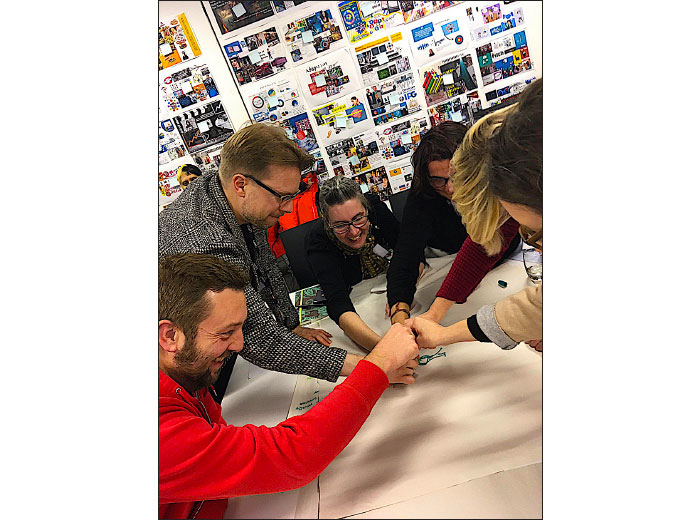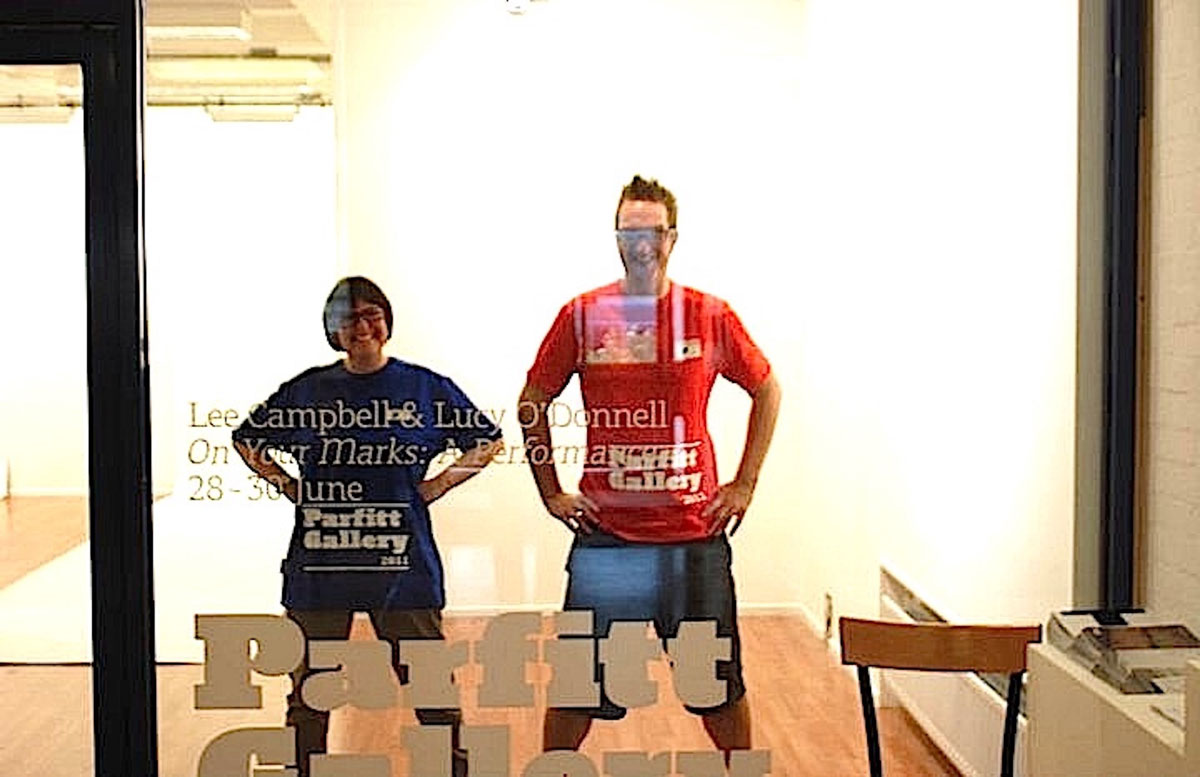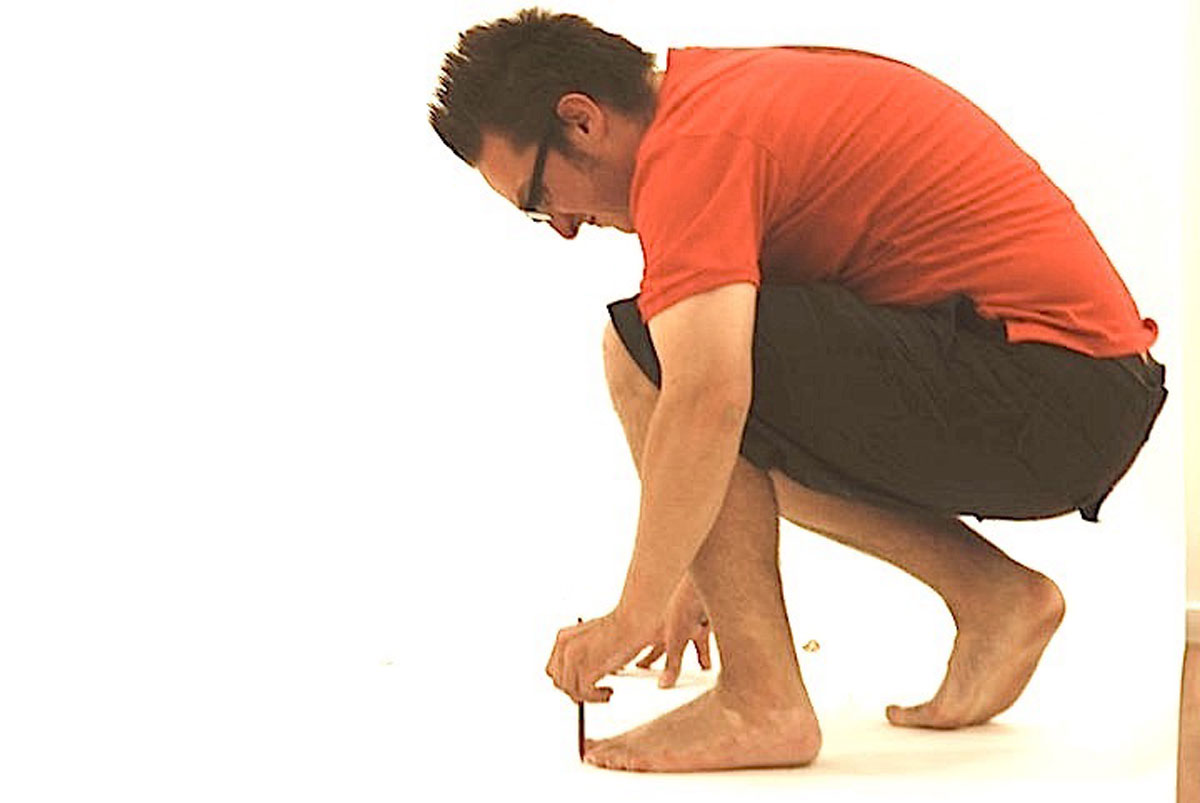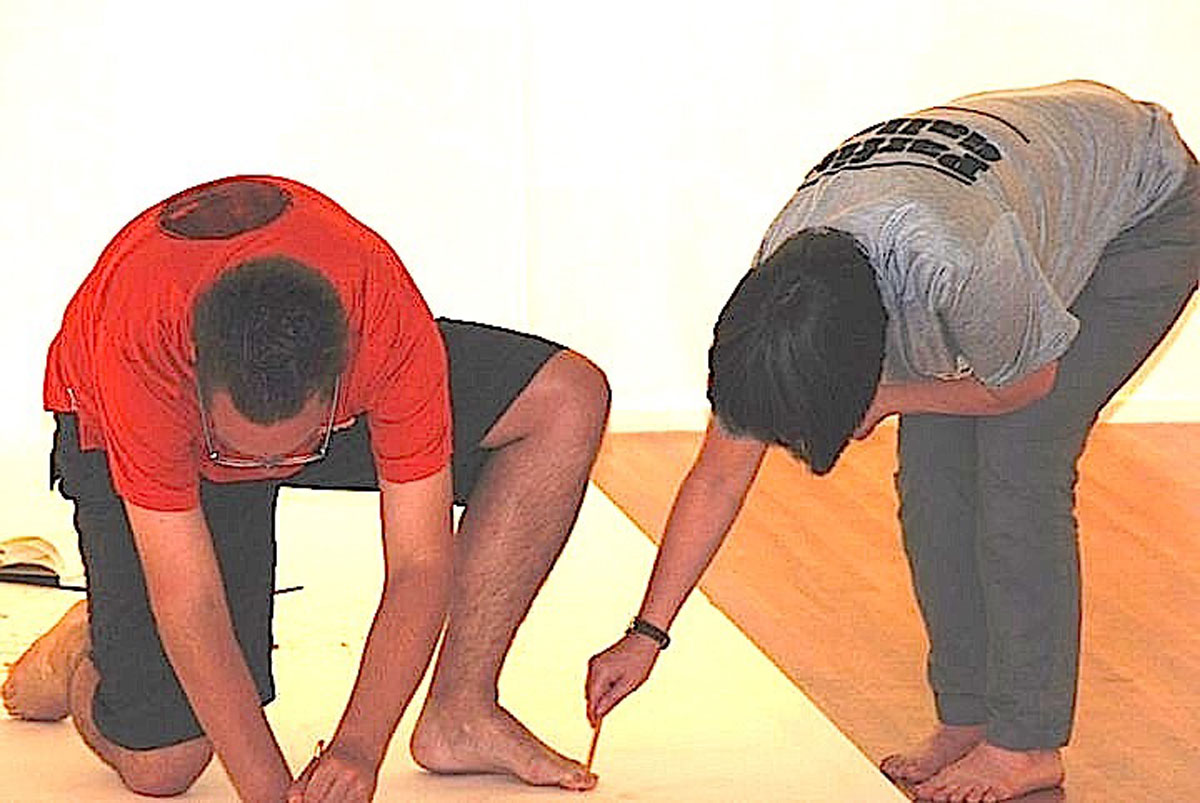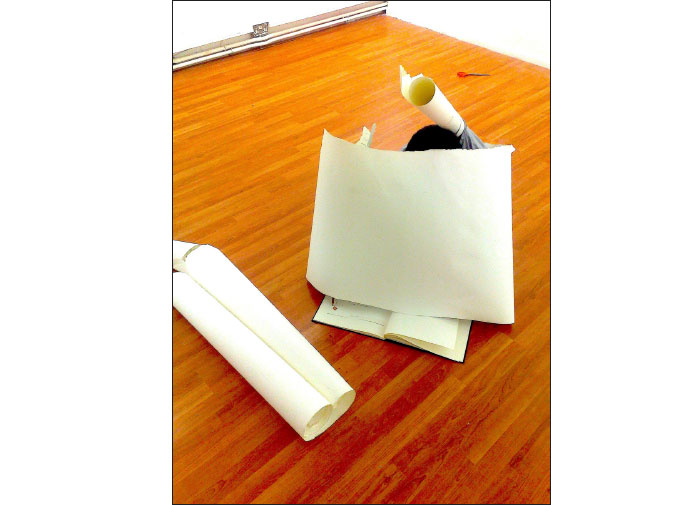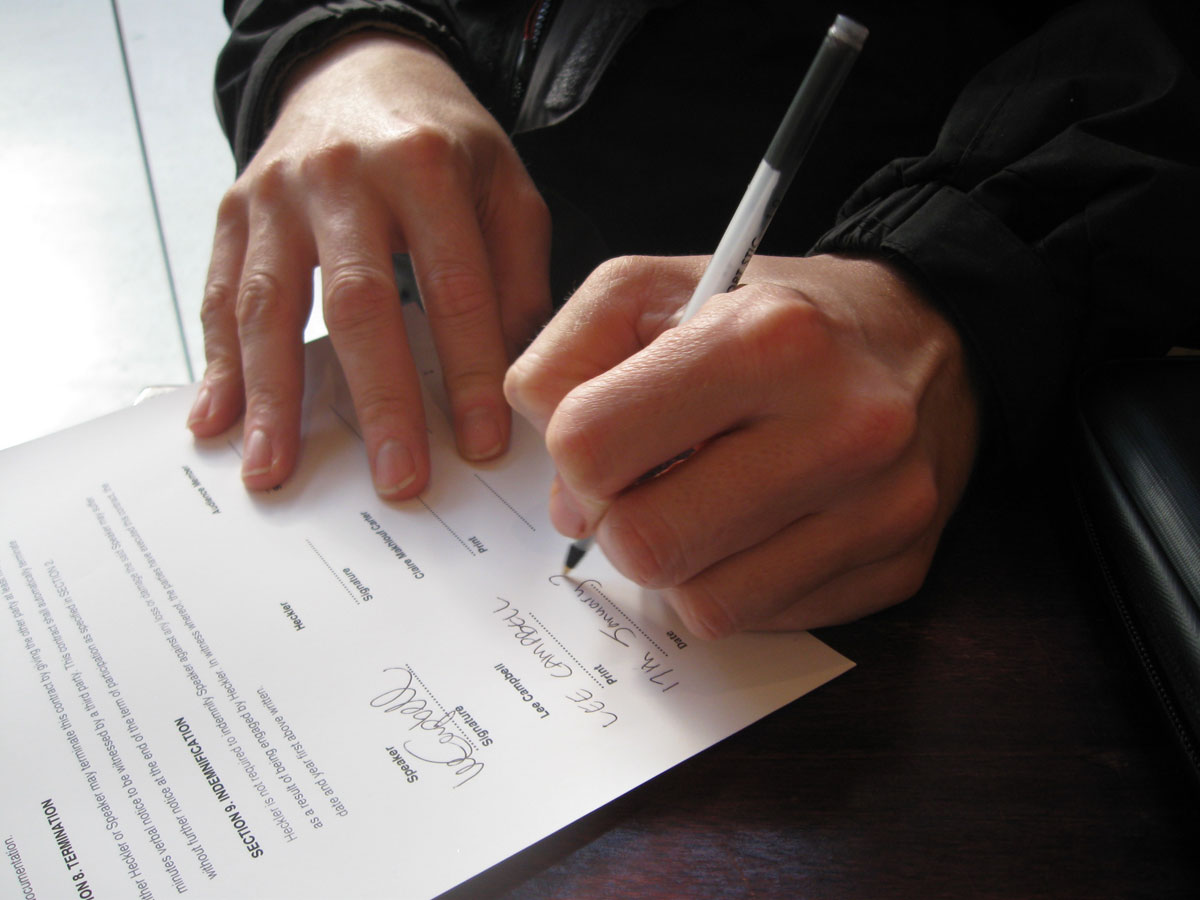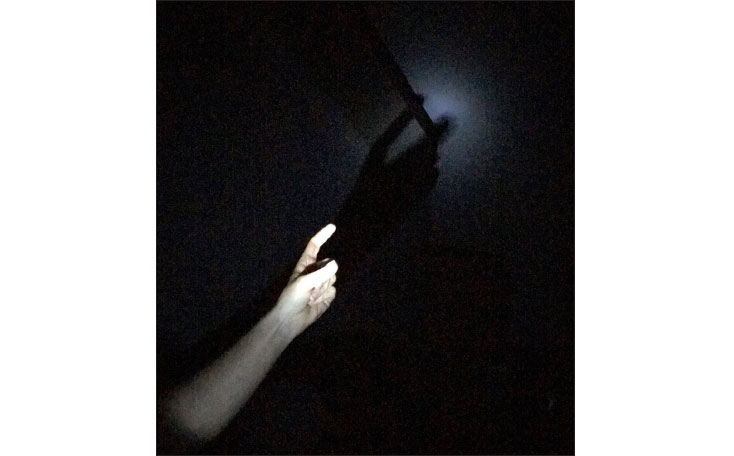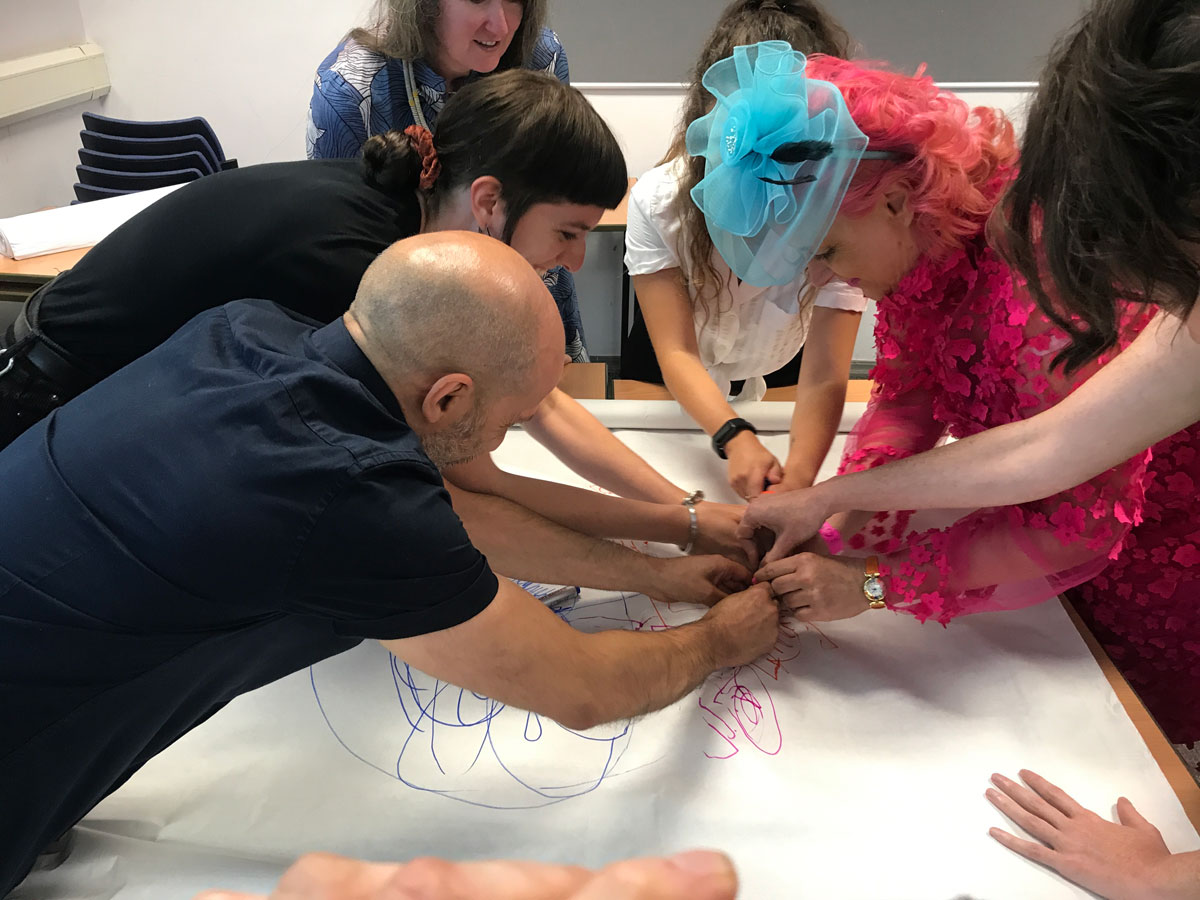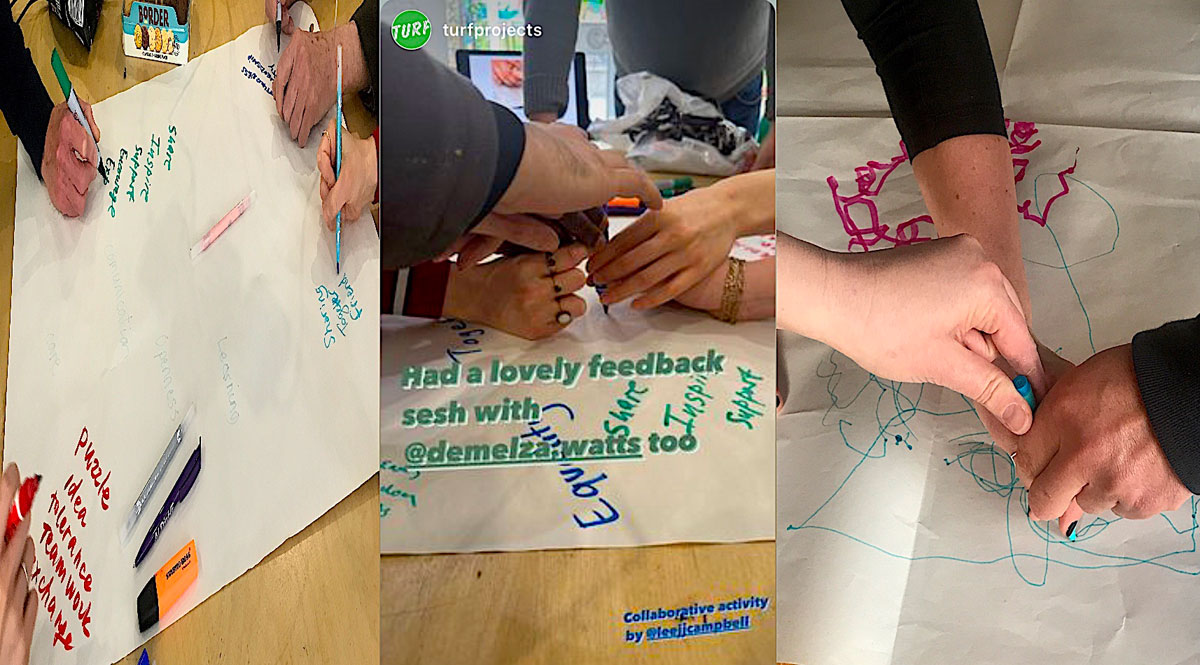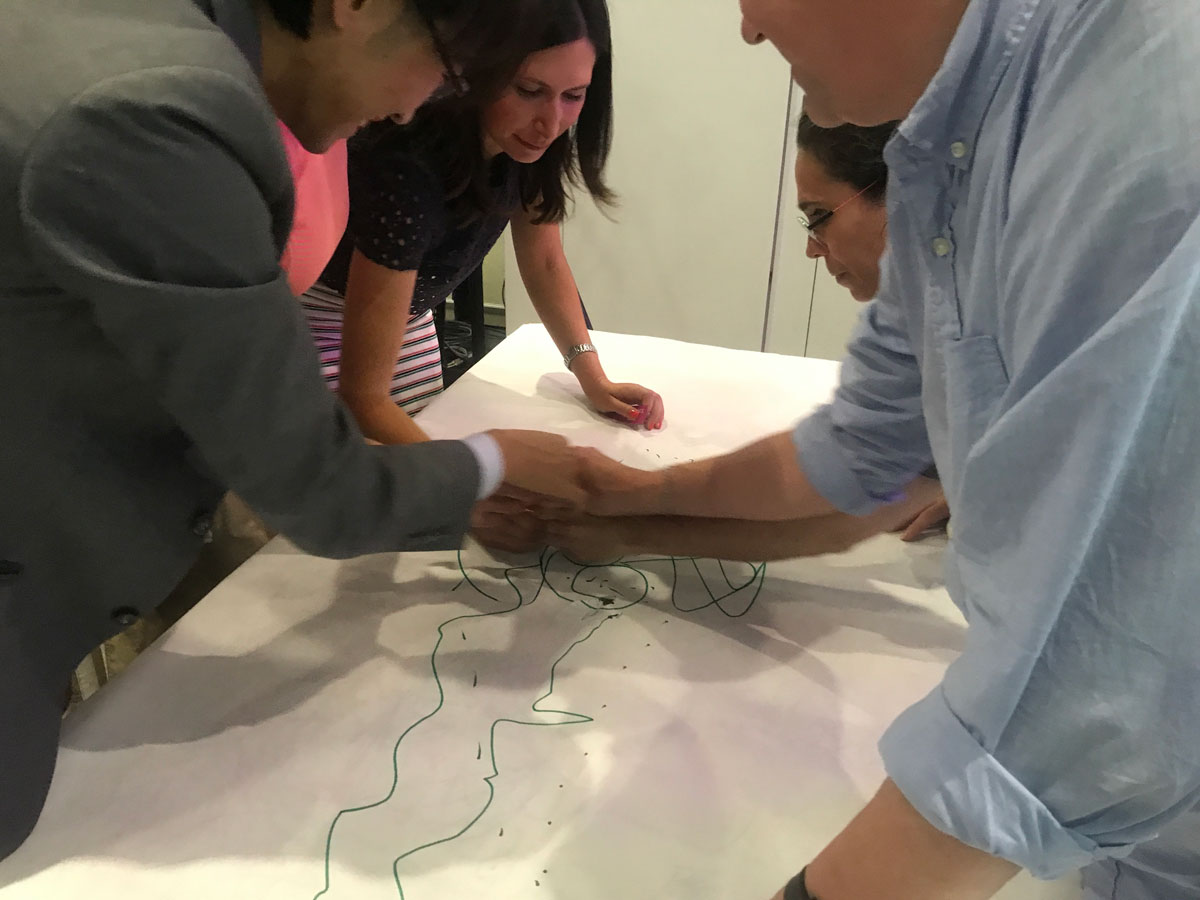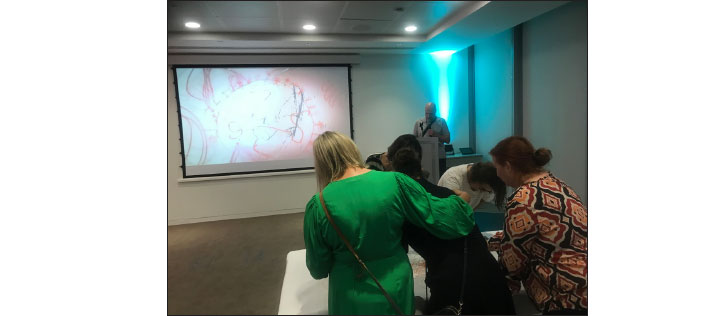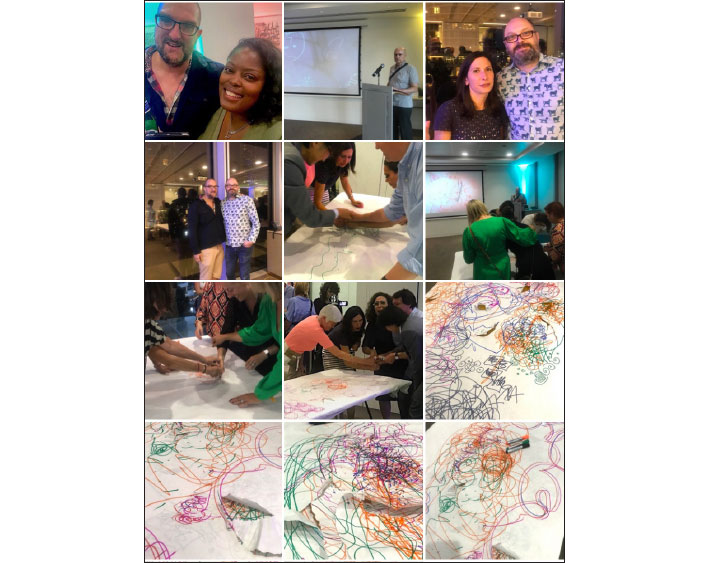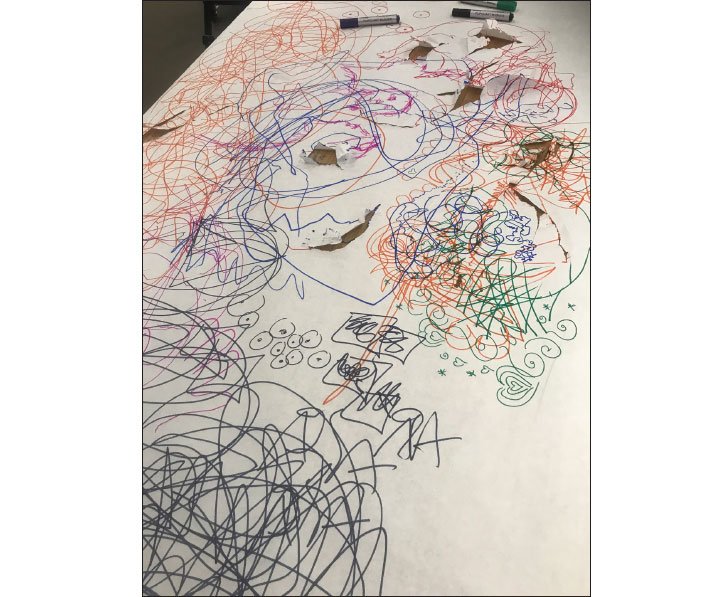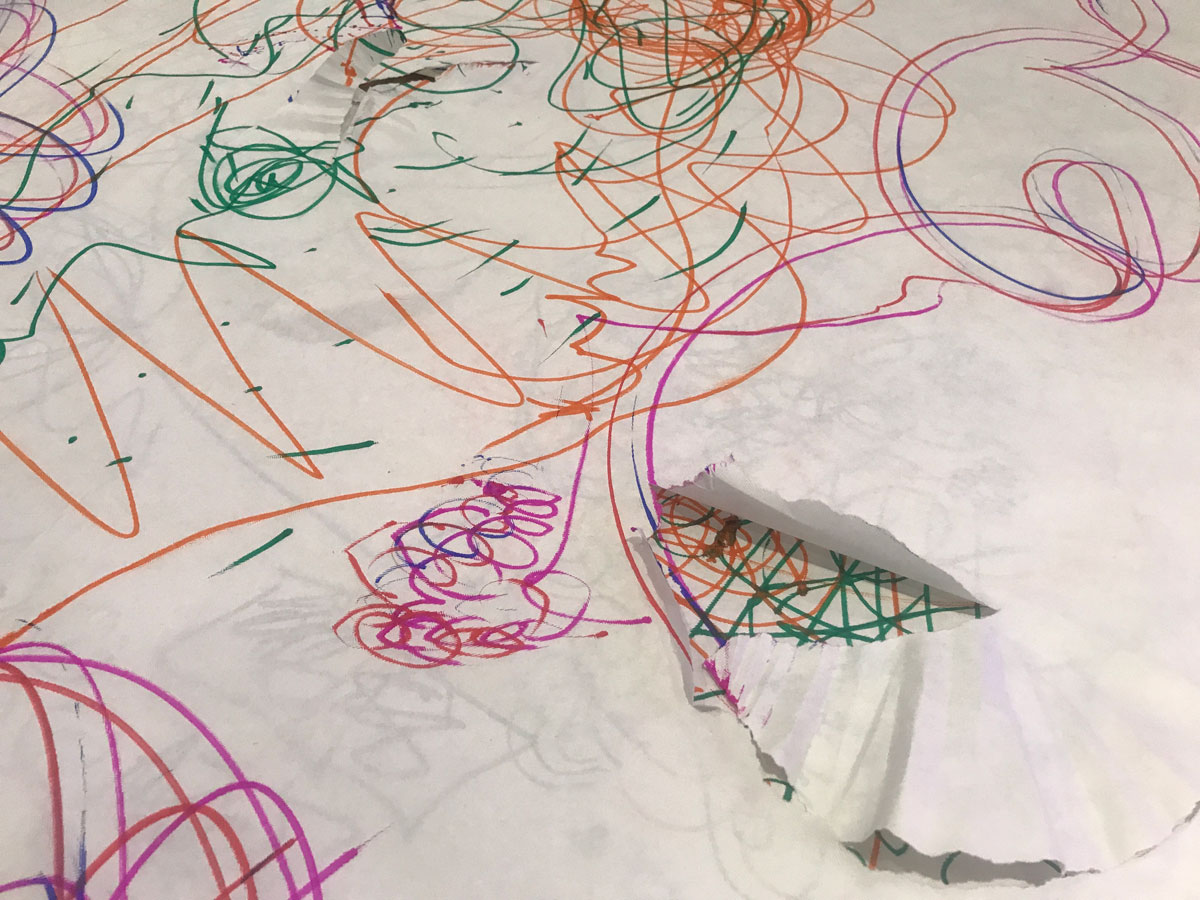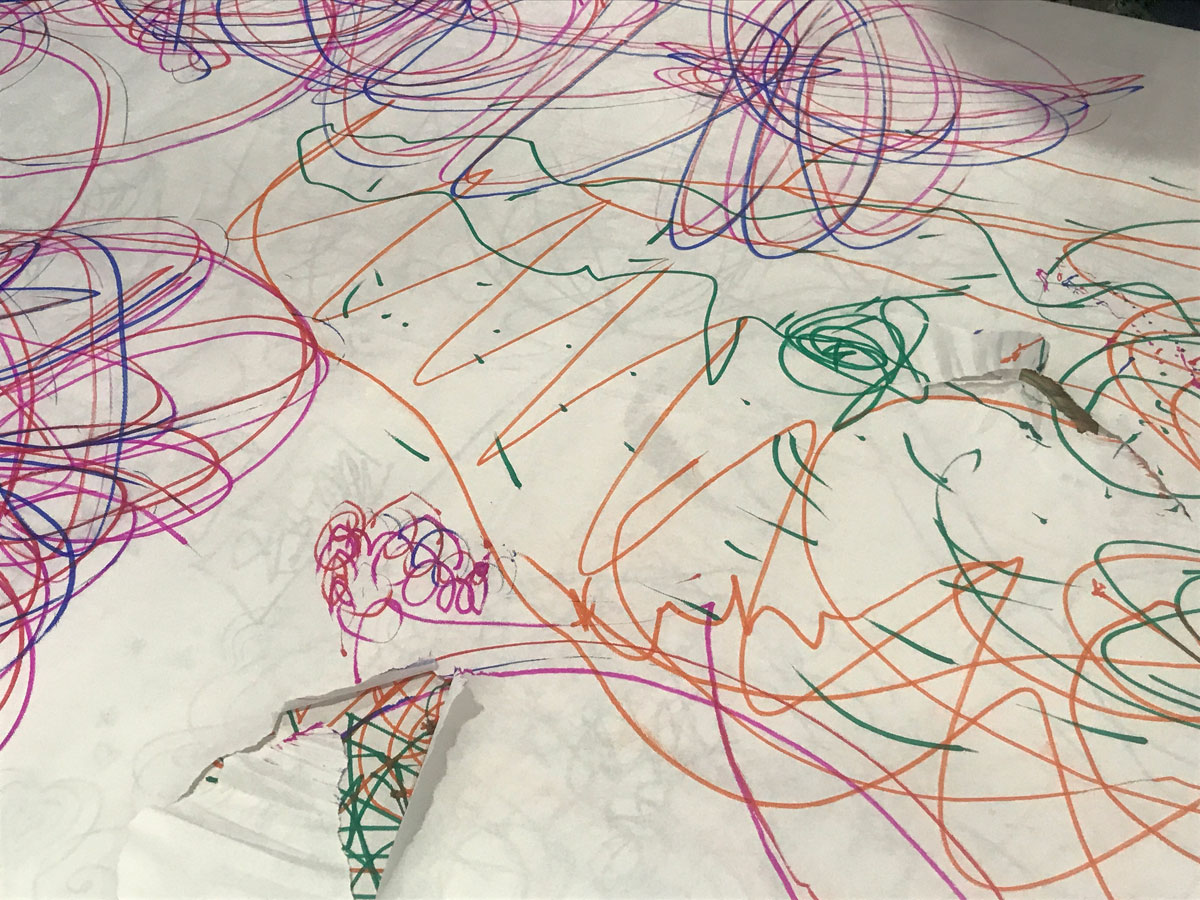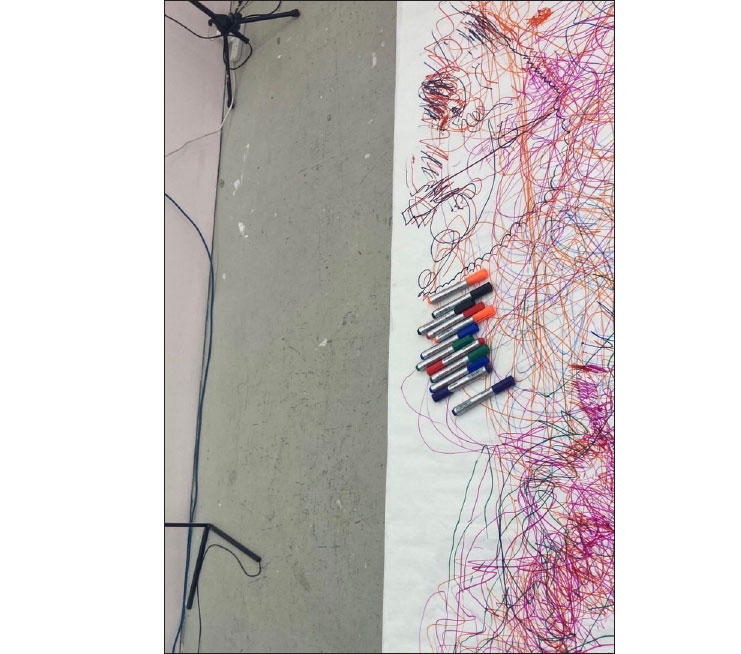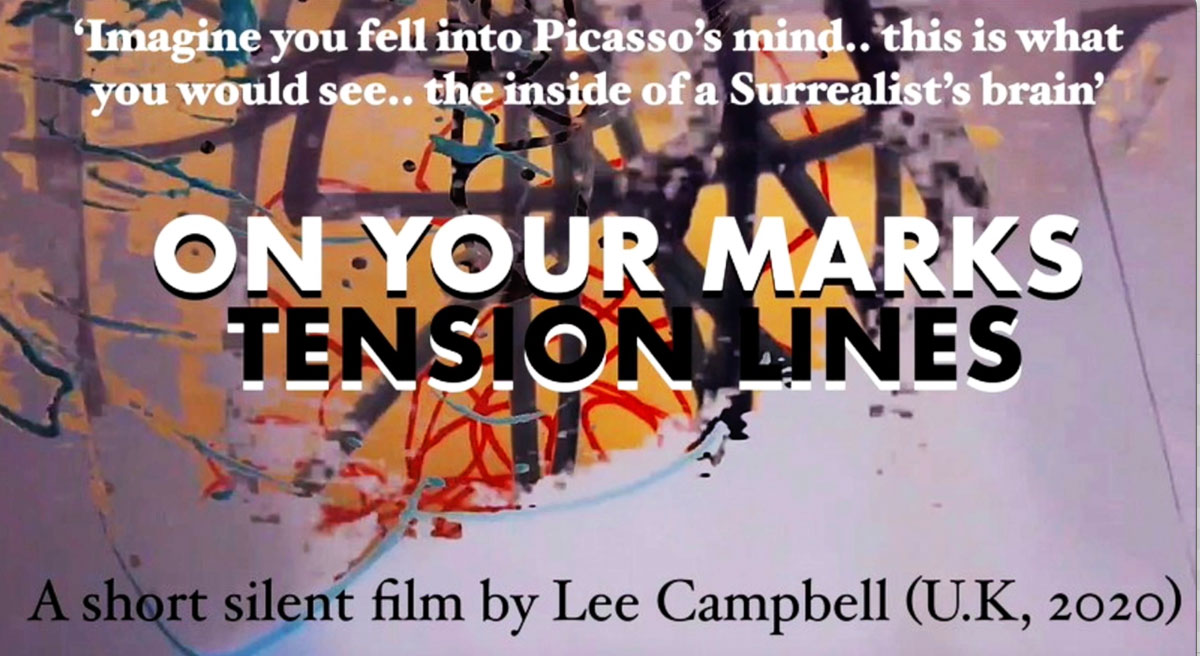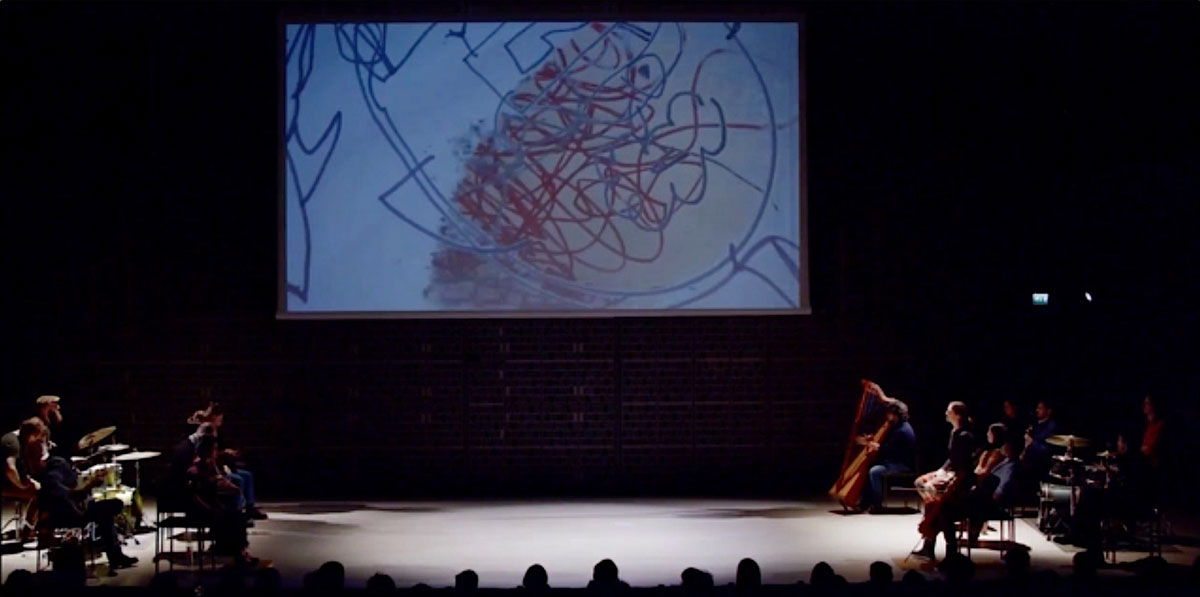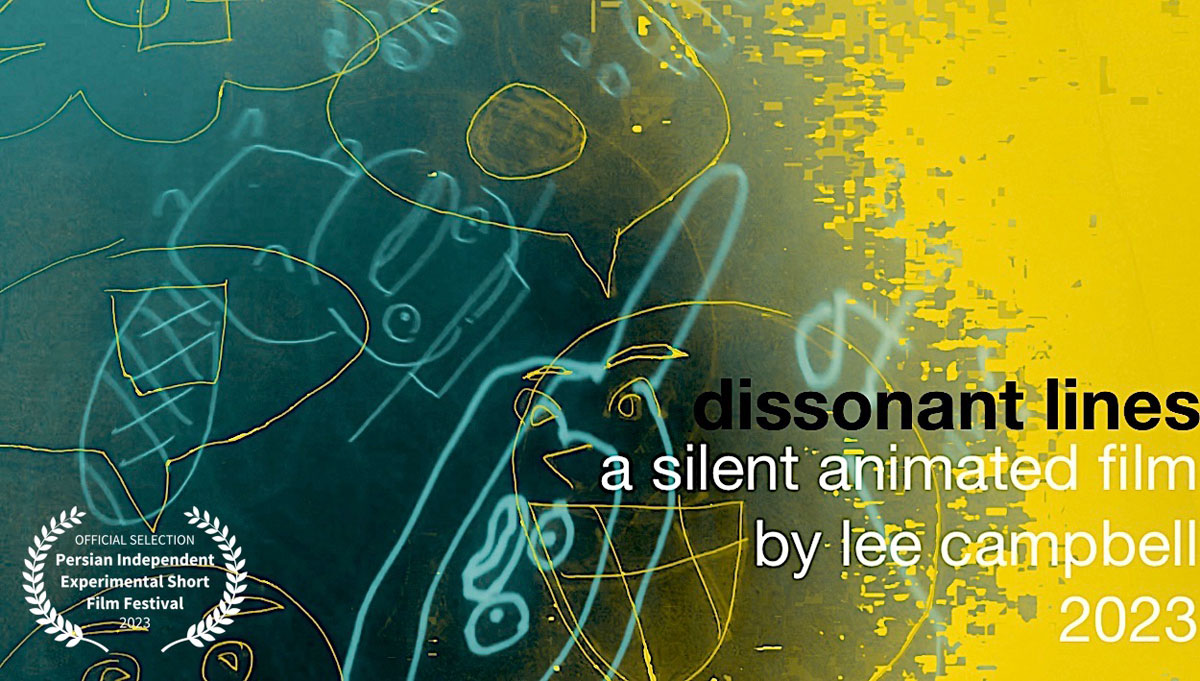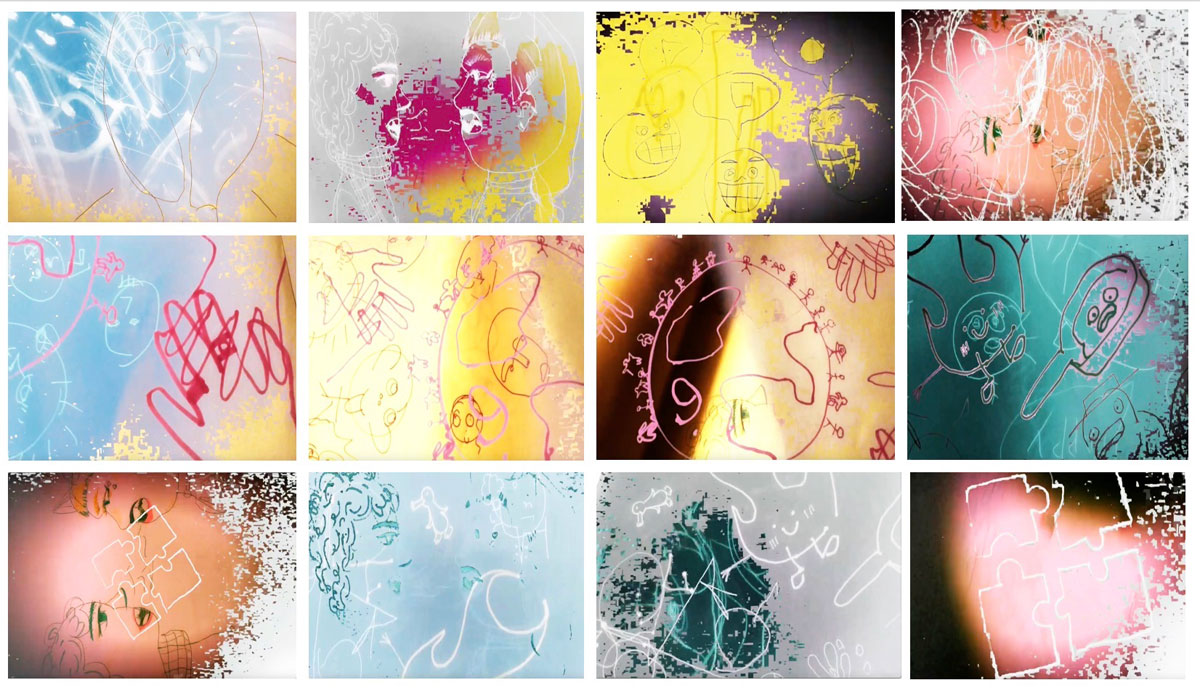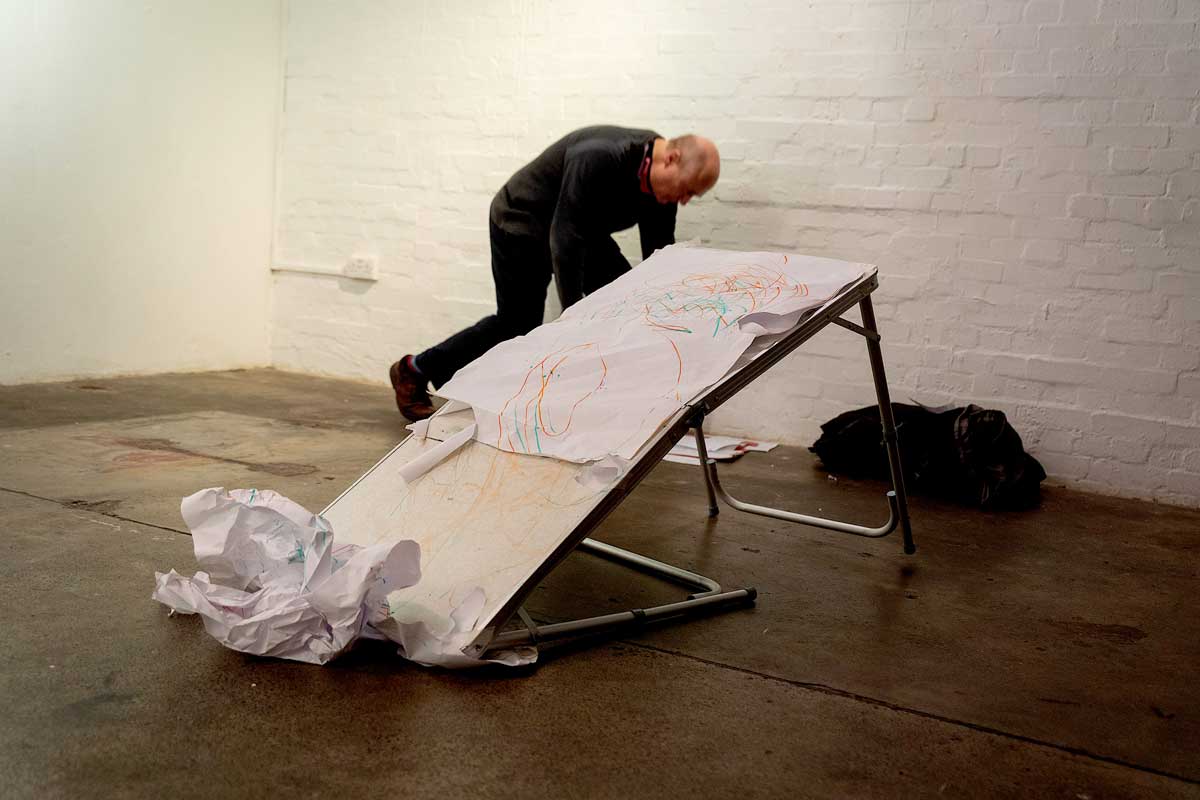Introduction: Early Explorations into The Politics of Collaboration and (Non)Co-operation through Drawing/Marking
Tim Etchells in Certain Fragments (1999) asserts ‘collaboration [is not] about perfect unity but about difference, collisions, incompatibilities’ (1999: 56). As part of wider concerns relating to (performance) art, audience, participation and collaboration (Billing, Lind and Nilsson 2007, Frieling 2008), since 2011, I have produced an extensive body of practice-as-within my practice that explores these ideas and examines the relationship between collaborative drawing (or more broadly ‘marking’) and self-relationality to ‘others’ and ‘place’ (Figure 1).
This work has been guided by a series of questions including: ‘What is understood as a ‘mark’ and ‘marking’? ‘How can marks convey or represent something? Is marking ‘embodied’?, What is ‘located’ in a mark?’, How are ‘marks’ understood as communication? ‘Can ‘marking’ be understood as dialogic and ‘How marks become indexical of their producer?’. From a shared interest in the location of the ‘Mark’, these questions were explored and evaluated through a series of conversations between two artists (myself and Lucy O’Donnell) during On your Marks at the Parfitt Gallery, London in June 2011 (Figures 2, 3, 4, 5).
Throughout the three-day micro-residency (Tuesday 28th ~ Thursday 30th June 2011), Lucy and I generated a whole range of different ‘marks’, which we vocabularised as sound utterances, visual marks on a surface and bodily gestures1. During the five day residency, we transformed the traditional white cube into a stage to perform in, play in and have fun in by utilising its physicality. Audiences could watch myself and Lucy marking through the windows or enter the space as the door was open. We prepared the gallery with sketchbooks and coloured sticky post-it notes and suspended a roll of white paper along the length of the gallery, all to be to marked with charcoal, black biro pen, or lead pencil. As the performances/conversations took place, communication between me and Lucy alternated between using the various paper mediums which all became obliterated and eventually destroyed by the end of the project. Leftover objects from a previous exhibition including text left on the wall and plinths that had not yet been removed were utilised as props. Each mark we made was an invitation for the other person to respond or in other words, we use ‘marking’ as a process in which to generate dialogue. ‘Marking’ was described as a means for a person to ‘mark’ and accentuate one’s presence by using their body as well as a means to mark one’s own boundaries and to demarcate in various ways power relations. ‘On your marks’ denotes competition. We were asked by an audience member in a discussion at the end of the project ‘Who came out on top?’ The ‘performative’ is a key concern for many contemporary artists. The body can be considered not just in terms of how the marks made by myself and Lucy embody ideas of collaboration but the act of making those marks is often in a very physical, super bodily manner. Informing these ideas, are how Maurice Merleau-Ponty envisages the body in within the ‘embodied’ act of painting (which me and Lucy extend to ‘marking’ more broadly):
The painter ‘takes his body with him’ says Valery. Indeed we cannot imagine how a mind could paint. It is by lending his body to the world that the artist changes the world into paintings. To understand these transubstantiations we must go back to the working actual body—not the body as a chunk of space or a bundle of functions but that body which is an intertwining of vision and movement (Merleau-Ponty, 1964:54.)
It is tempting to look at paintings as static objects. Merleau-Ponty, however, reminds us of something we perhaps always knew, at some level at least; that painting (and by association, marking) and the body are intimately connected. This is interesting because, as he says, the body is itself not just one amongst other objects, or one chunk of space amongst others but is an ‘intertwining of vision and movement’. We can apply these ideas to the ‘super-bodily’ practices of artists Jackson Pollock dripping paint onto canvas, Yves Klein sliding the painted bodies of naked women over canvas and Janine Antoni soaking her hair in black hair dye before using it to map the gallery floor.
During On your Marks, Lucy and I examined the extent to which the residue (i.e. the drawings) of acts of drawing and marking can be viewed not as a collection of static objects but as records of the intertwining of vision and movement. Furthermore, how these records can be a source or component of a new type of ‘post-performative drawing/marking’. During our residency, we constituted drawing and marking as performative and used the act of marking to remark on the phenomenological relationship we had with each other. Through an extended vocabulary of what constitutes ‘drawing’ by naming it as ‘marking’ with marks made require a response, we produced an energy which played itself out in the live physical moment that could be broken down into two simple considerations. Firstly, the moment where one of us were going to make a mark and how were we going to indicate this and secondly, the repercussions of having made such a mark. It was our intention to test friendly reciprocity, evaluate how physical presence and absence could be marked and begin to understand how marks become indexical of their producer as we began working in the gallery space treating it as a contingent testing ground; everything in constant flux. In this way, we interrogated how physical space could be punctuated with our bodies in a communicative and expressive way. Marks were signs of hospitality, reflective of the reciprocity between a host and a guest. The offering of a mark to the other person was an invitation. Accepting the mark displayed conviviality, rejecting it produced antagonism (Bishop, 2004). This constant action of accepting and rejecting marks determined how the dialogue between myself and Lucy would proceed. The act of marking made visible the politics between us as we marked personal boundaries.
In the years that followed the residency, I produced further artworks exploring the politics of collaboration in art practice and ideas around the non-cooperative participant.
This included Contract with a Heckler (2013) (Figure 6), an artwork co-produced with artist Claire Makhlouf Carter that trials a performance about heckling via the act of heckling (Campbell, 2017, Campbell and Jordan, 2018). A hilarious articulation of the dynamics of collaboration, How Can I Get My Partner to Be My Finger? (2019) combines comedy, movement and visual performance and takes the form of a conversation where two speakers (my fiancée, Alex and I) don’t quite meet (Figure 7).
A performance all about control and my feelings in relation to another. It is a performance of tensions between the active and the passive of who is in control and who is being a puppet. In many ways, Alex makes a critique of me the pedagogue, of my pedagogical position. He is non-cooperating – the ultimate non-co-operator for a pro-participatory pedagogical practice. He is constantly trying to put a spanner in the cooperation/collaboration2.
Collaborative Marking: Marker Pen Performances (2019 – now)
Can acts of group drawing or marking embody the tensions and complexities of collaborative working?
How can drawings/marks made during these acts be indexical of not just the actions of the group but enable a questioning of the self in relation to others?
These questions above have formed the foundation for an audience participative artwork that I have produced various iterations of in various contexts and artistic and pedagogic settings including art galleries, lecture theatres and university workshop/seminar rooms since 2019. During their participation, participants experience the tensions of collaboration through an embodied collaborative drawing activity entitled Collaborative Marking: Marker Pen Performances (Figures 8, 9, 10, 11, 12).
The first iteration of performance activity was part of the launch for my two part book volume on critical performative pedagogies, Leap into Action (Campbell, 2020) at London College of Communication in December 2019. Due to the Covid-19 lockdown pandemic and the need for social distancing (it would have been impossible to have enacted the activity given the very close proximity /level of physical intimacy participants have with each other), I did not generate the activity again until September 2022 as part of a practical workshop on collaboration skills I designed and delivered to students at Wimbledon College of Arts. The activity was not then performed again in public until Summer 2023 and this time, I worked in partnership with Nick Eisen3.
To explain the process, participants first gather around a table with a sheet of paper and a marker pen and are then invited to hold the pen together at the same time and move the pen together across the page to mark the paper. Everyone needs to find a space on the pen. They are instructed to respond to certain things that catch their attention as they draw together and listen to a piece of text being spoken out aloud. Starting at Radical Repetition which I curated for London Critical Thought Conference 2023, I invited performance poet Nick Eisen to read aloud his poems which contain multiple forms of linguistic repetition read at different speeds and tempos, often changing in gear rapidly. Alternatively, participants are asked to choose a word and not to tell others what the word is. A previous participant commented that ‘If we do not know what another’s person’s choice of word is, you’ve got to trust that everybody else in the group is going to do the word you have personally chosen. We assume somehow we are all on the same wavelength but we’ve all got different words. I feel I am in a space of trust here’. Participants then try to draw that word (not using letters) and at the end of the activity is the big reveal as to what word each participant had chosen. On some iterations, alternatively, participants have all held the same word. Participants knowing the word is the object, not a concrete tangible object but is still a common point of reference. The drawing process, marking the paper with the same pen, everybody touching the same pen at the same time, often produces so much (uneasy) laughter. Participants are then instructed to complexify the process at different stages, e.g. with one person instructing and the others with their eyes closed, swapping hands (to the hand participants normally write with), kneeling on one foot, engaging in a balancing act, do the activity in silence etc.
The resulting drawings are about the dynamics of a group and who controls the pen – who leads? (Figures 13, 14, 15, 16). In Archive or Memory? (2003), Matthew Reason describes Forced Entertainment’s performance space as, ‘[l]ittered with traces of what has gone before, traces of the performance which were present but now has gone’ (Reason, 2003: 88). The marks of the resulting drawings are embodied visible traces of the complexities that underpin collaboration, ‘leftover’ (ibid.) embodiments / embodied debris of the tension participants felt throughout the activity.
Participants have previously expressed that engaging in the collaborative pen holding and feel it move across the paper felt akin to that those they experienced when using a Ouija board and also taking part in a séance. Moreover, in terms of seeing the dynamics of collaboration visibly on a page, one participant commented ‘this activity perfectly embodies collaboration. Collaboration is about being in the world unless you want to be alone in the woods somewhere’. What happens when the drawing/marking goes in directions that a group member may not like? ‘There’s a limit to politeness to get the job done!’, one participant has previously remarked. The marks made on the paper are indexical of “who’s in charge” in collaboration, even in just holding something together, is there equity in how it (the pen) is held? ‘I wonder who is leading and who is following’ another participant has previously remarked. This idea of ‘equitable holding’ could be applied to many different contexts. Another participant usefully remarked,
Where you hold the pen influences the movements and decisions, and energies. Does the person at the bottom have more power? We always think of a top down hierarchy but maybe the person at the bottom is the grounding one who provides the stability, the leadership might come from the top but are not actually the ones controlling it… or maybe the middle one is the mediator between top and bottom. Quite a lot happens in the middle – if directives come from here it gets converted and then gets stabilised. Is the person holding the pen at the bottom holding the power at the base? Are they grounding the process so everyone else feels safe and secure? Is the person in the middle playing quite an important role mediating between the one who’s directing from the top and the one holding at the base?
Whilst the activity clearly stimulates discussion about collaboration and working/relating with/to others, it also encourages deep self-awareness and elevating participants’ consciousness of themselves in terms of their own subjectivity in relation to others and in relation to the space(s) they are in. A further participant commented in relation to these ideas that:
The activity opens up a lot for you to discover about yourself working in a team. The beauty of the work’s playfulness is the easy access point for doing work which is actually quite deep. Participants are asked to embody something, there’s a lot of trust involved in this process and dealing with things that are quite abstracted, delving into that inner abstract space of thoughts and feelings so to do so in a playful manner is a really useful access point. The push and pull against each other – similar to the experience of learning to question, taking feedback, trusting in a process rather than the outcome, more important to being present in the moment as the pen progressed meaning that I had to surrender whatever I was holding on to so that I could be part of a larger process. The activity has the potential to go very deep … Really lean into this work’s meditative quality
The finished drawings also point to how time can be understood beyond that of a durational work in this, as time can also be considered as being an aggregate of thought. The drawings create an aggregation of time coming through in the sense that you can still feel the tension of the marks being made on the paper even if you can’t see it or hear it. Whilst the drawings open up an opportunity to discuss the complexities of collaborative working, the drawings speak to how time and duration within a static image and ideas and thoughts and even processes of their production may be ‹revealed› over time. In other words, how the form and content within supposedly ‘flat’ static surfaces can, through looking, reveal themselves over time.
On most occasions of enacting the artwork in various spaces, the resulting drawings depict lines and abstract forms, however, in a previous iteration at Wimbledon College of Arts, the drawings depicted more figurative elements e.g. peoples, objects and things. Upon seeing those figurative elements, a viewer remarked,
How did they do those drawings? They must have communicated with each other in some way, a ‘hive’ mentality (when you enter a space of shared consciousness that you are not necessarily aware of because of the situation you’re tuning in) – a pre-meditated consensus before about what they are going to draw. An example of building trust with people
A recent iteration of the drawing activity was at Live Art Club, Deptford (01.10.23). Whilst one of the participants suggested after the performance that the length of the activity (10-15 minutes) was enough time to experiment and figure the process out and not get too tired (as for her it was quite tiring having to focus after 10-15 minutes), I was intrigued by Nick’s responses to a series of questions (below) that I posed to him shortly after:
Lee
It’s been great having you part of this project, Nick. What have been some of your most vivid memories so far? How does it feel to see the participants undertake the drawing activity as you read your poetry out aloud in front of them?
Nick
It’s been great to be part of the project – thank you! Most vivid memories so far in no particular order – Seeing people swaying/dancing to the rhythm of Millions of People and moving round their group drawing in a kind of drawing/poetry dance; the fan-shaped rip in one of the group drawings, which I found beautiful and also emphasised how involved those participants were in the experience. Many thanks to all who took part. Thank you for taking those lines of marker pen and felt tip for a walk and a dance, and for overcoming any reservations. Creativity, I think, is partly about overcoming certain reservations.
Being part of the process was for me, memorable in itself. It made me think again of art as process rather than product, and of relinquishing/sharing control and overcoming self-consciousness in order to create – something, I believe, those who want to work creatively must practise. Watching people draw, as I read, made me see them as actively responding to my writing – with more/all of their bodies. I saw their collective response as more physical – more about feeling rather than conscious thinking. Of course, I’m just echoing in a very small way Keats’s wish: “ O for a life of Sensations rather than of Thoughts”
Lee
Do you think this work could be translated online/to the digital space? If yes, how so? Or if not, why not?
Nick
Yes – Online games & fitness classes could perhaps offer a template. As almost always, in-person would offer more as an experience, but I think groups could get together around their own tables and speakers for in-person sessions. Joining online could also be a step towards joining in person.
Lee
After recently taking part in the activity at Radical Repetition, our mutual friend Steve (Tasane) shared with us that he wondered what would happen if, rather than participants working on a blank piece of white paper, they were responding to an image of something e.g. a map, an aerial view of the city of London, a copy of the Mona Lisa painting etc. What do you think about this idea?
Nick
Steve has excellent ideas; I’d say maybe give it a try. I’d wonder if that could be information overload and whether it might overcomplicate things – generally, I favour keeping things simple. But I also favour experiment and exploration – so if it can be tried, yes. Would it be worth having pictures at 50% or 75% opacity (white) so the pen lines don’t get too lost against the underlying pictures? Or drawing on a translucent overlay over the picture? Or projecting images onto a disposable paper screen and drawing on the blank screen? Or is that all too complicated!?
In its most recent iteration, when the participants drew as part of Presence at Hundred Years Gallery, London, the table which they were using to draw the paper onto collapsed (see the last two links in Notes 4.) This became a happy accident to think through ideas as Nick explains:
Nick
Many thanks to those wonderful members of the audience who stood up & helped create this moment – & to all for their enthusiastic support! Layers of truth & perception – The table collapsing was a powerful, striking, compelling image – maybe of the way truth collapses perception /perception/belief collapses truth? That’s what creative events/ happenings are all about, isn’t it?
Indeed, as performance poet Pip McDonald remarked upon seeing the collapsed table’, ‘Rules (and tables) are meant to be broken’. A participant who took part in the action when the table collapsed further remarked, ‘I really enjoyed it. I felt like we were ripping the paper. You don’t know if you are leading or not. Sometimes you are and sometimes you’re not. You don’t know where anyone else is going. Like a Ouija board. Who is leading? Is the pen leading? What if you lose touch with it? Will it go on by itself?!’
Mediating the Leftovers
My practice has long explored the relationship between liveness, performance and its documentation (Campbell, 2014). Bringing the leftover drawings from the collaborative pen holding drawing activity into my film practice, I have so far produced two short silent films On Your Marks: Tension Lines (2020)4 and Dissonant Lines (2023) which animate the drawings5 (Figures 17, 18, 19, 20). I describe both films as hypnotic, painterly and poetic animations that show concrete poetry in film. Both films remove the author; an interesting change as my work is often about identity and my own autobiography (Campbell, 2022).
To explain the process of their production, the drawings are documented and filmed with the camera moving across the drawn paper. Now digital, the drawings are layered over one another. Green screen processes are applied to create arresting tensions between the lines and imager and fleshy layers seeping underneath and being revealed, and other sets of imagery coming through. Lines and imagery come together and clash producing a creative disruption that leads to new images and lines being produced, borders dissolving and then reappearing. Clashing lines create new possibilities for redefinition. In Dissonant Lines, the viewer gets to see the drawn pages being turned over, sparking intrigue as to what is over the page, underneath the page and on the flipside to the page being turned. A disembodied hand appears in the film turning the pages. The original drawings have a link to cave paintings. The viewers try to build a narrative from the drawings. There is something really primal about the mark making; the marking seems to come from a really internal place. The marks without sound makes you stop from thinking about the moment it was drawn and now, put into a different space, the viewer concentrates on the layers – all these tensions in the lines being made. Dissonant Lines was recently exhibited as part of Pride is an Abstraction at Clifford Chance, London between June-September 2023.
Below are the words of the exhibition’s curator Michael Petry on the opening night:
Normally when you say ‘Pride exhibition’ a lot of things come into mind but normally that’s figurative which is fine but I really wanted to focus on artists within our community who are making abstract work. Not something you would normally see in a Pride show. When you are a kid, you start off being an abstract artist. Children draw in a very abstract way. Then someone slapped your hand and says, ‘No, you make a flower like this … this is how you should make art’. Starting out with colour and form which everyone does naturally you are told to be something else. And within the art world there is a whole new line of thought about queer abstraction. [Speaking about Dissonant Lines] I believe Lee had groups of his students make the drawings together and they had one pen, and they had to hold onto the pen at the same time altogether and make the drawings, very abstract and very conceptual which Lee has then made into a very layered and complex video with no sound or music. Very beautiful
Final Thoughts and Future Practice
The image of the collapsed table (Figure 21) as sculpture within itself at the end of me and Nick’s recent performance as part of Presence, Hundred Years Gallery is so striking and evocative.
Table turned sculpture rather than picture. It captures the very spirit of the poems that Nick read aloud – of carrying on through order and chaos. As shown in the last two video links supplied in Note 3 below, the participants trying to salvage the paper back onto the table shows how they are trying to cope with the energy and the chaos and carry on creating through the chaos. Creating through the things that you don’t know are going to happen is, for myself and Nick, at the very essence of the human condition. Discussing ideas about our next steps forward with the work, we’ve thought more about participants creating drawings on surfaces other than white sheets of paper. One surface could be newsprint. Not only is newsprint cheap, but it is also not too dominant that may make the drawings that the participants create disappear. Newsprint creates a relationship and a tension because it is not dominant but we also like the idea of using newsprint where there might be imagery and pieces of text which is dominant so to see what happens in terms of participants drawing over/across/through certain images and text. We have also discussed about making our own disposable cardboard tables which participants draw directly onto and we do not mind it getting totally trashed. We could use upended cardboard boxes as table. If participants want to draw on the sides, they can, and if they want to rip it up, they can. We like the idea that cardboard boxes are collapsible; we could carry them to the performance venue but envisage that getting them home as sculptures may prove difficult. Therefore we would like to explore leaving them in the performance space after the performance to be looked at and viewed and then destroyed after being documented. We are also considering creating a parody of a suburban living room made out of objects drawn on/cardboard furniture drawn on and potentially smashed up.
Notes
- To watch video documentation as one of me and Lucy’s performances /conversations during On Your Marks (approx. 1 hour), click here: https://filmfreeway.com/onyourmarkswithlucydonnell [^]
- To view a recording of How Can I Get My Partner to Be My Finger? (2019) click here: https://filmfreeway.com/HOWCANIGETMYPARTNERBEMYFINGER [^]
- To find watch documentation of these performances, click on the following links: https://filmfreeway.com/DRAWINGPERFORMANCEWITHNICKEISENATRADICALREPETITIONLONDONMETROPOLITANUNIVERSITY01 https://filmfreeway.com/DRAWINGPERFORMANCEWITHNICKEISENATLIVEARTCLUBDEPTFORDLONDON01slash10slash23 https://filmfreeway.com/DRAWINGPERFORMANCEWITHNICKEISENATPRIDEISANABSTRACTIONCLIFFORDCHANCELONDON05slash https://filmfreeway.com/ONYOURMARKSATPRESENCE https://filmfreeway.com/ONYOURMARKSPRESENCE2 [^]
- To watch On Your Marks: Tension Lines (2020), click here: https://filmfreeway.com/ONYOURMARKSTENSIONLNES [^]
- To watch Dissonant Lines (2023), click here: https://filmfreeway.com/DISSONANTLINES2023 [^]
Competing Interests
The author has no competing interests to declare.
Author Information
Dr Lee Campbell is an artist, performance poet, experimental filmmaker, writer, Senior Lecturer at University of the Arts London, and curator/founder of Homo Humour, the first of its kind project on contemporary queer male film and moving image practices that explore humour and LGBTQ+ storytelling and has screened all over the world since 2020. His experimental performance poetry films have been selected for many international film festivals since 2019. Lee had his first solo exhibition in North America of his poetry films, See Me: Performance Poetry Films at Fountain Street, Boston, Massachusetts, U.S.A (July 2022) and his film SEE ME: A Walk Through London’s Gay Soho 1994 and 2020 (2021) won Best Experimental Film at Ealing Film Festival, London 2022. His debut poetry collection SEE ME: An (Almost) Autobiography will be published in 2024.
References
Billing, J., Lind, M., and Nilsson, L. 2007 Taking the matter into commonhands: on contemporary art and collaborative practices, London: Black Dog.
Bishop, C. 2004 ‘Antagonism and Relational Aesthetics’, October, Fall 2004, No. 110, 51–79. DOI: http://doi.org/10.1162/0162287042379810
Campbell, L. 2014 ‘Beyond Pollock: On visual art objects as non-traditional forms of performance document’, edited by Toni Sant, The International Journal of Performance Arts and Digital Media. Vol. 10, Iss. 1, 2014. Available at https://doi.org/10.1080/14794713.2014.912499 [Accessed 30th September 2023].
Campbell, L. 2017 ‘Collaborators and Hecklers: Performative Pedagogy and Interruptive Processes’, Scenario – Journal for Drama and Theatre in Foreign and Second Language Education, Volume XI, Issue 1/2017. Available at https://doi.org/10.33178/scenario.11.1.5 [Accessed 30th September 2023].
Campbell, L. (eds) 2020 Leap into Action, Bern, Switzerland: Peter Lang US. Available at https://doi.org/10.3726/b15265 [Accessed 30th September 2023].
Campbell, L. 2022 ‘Let Rip: Ripping, Remixing and Reinventing Materials and Me’. Moving Image Artists Journal. Available at https://movingimageartists.co.uk/2022/03/25/let-rip/ [Accessed 30th September 2023].
Campbell, L., and Jordan, M. 2018 ‘The Heckler’s Promise’, Performance Paradigm 14, Performance, Politics and Non-Participation. Available at https://www.performanceparadigm.net/index.php/journal/article/view/216/0 [Accessed 30th September 2023].
Etchells, T. 1999 ‘On Performance Writing’, in Tim Etchells (ed.) Certain Fragments. London: Routledge.
Frieling, R. 2008 The Art of Participation 1950 to Now. San Francisco; London: Thames & Hudson.
Merleau-Ponty, M. 1964 ‘Eye and Mind’ in The Primacy of Perception. ed. James E. Edie. trans. Carleton Dallery. Evanston, IL: Northwestern UP.
Reason, M. 2003 ‘Archive or Memory’, New Theatre Quarterly 19: 8. DOI: http://doi.org/10.1017/S0266464X02000076
